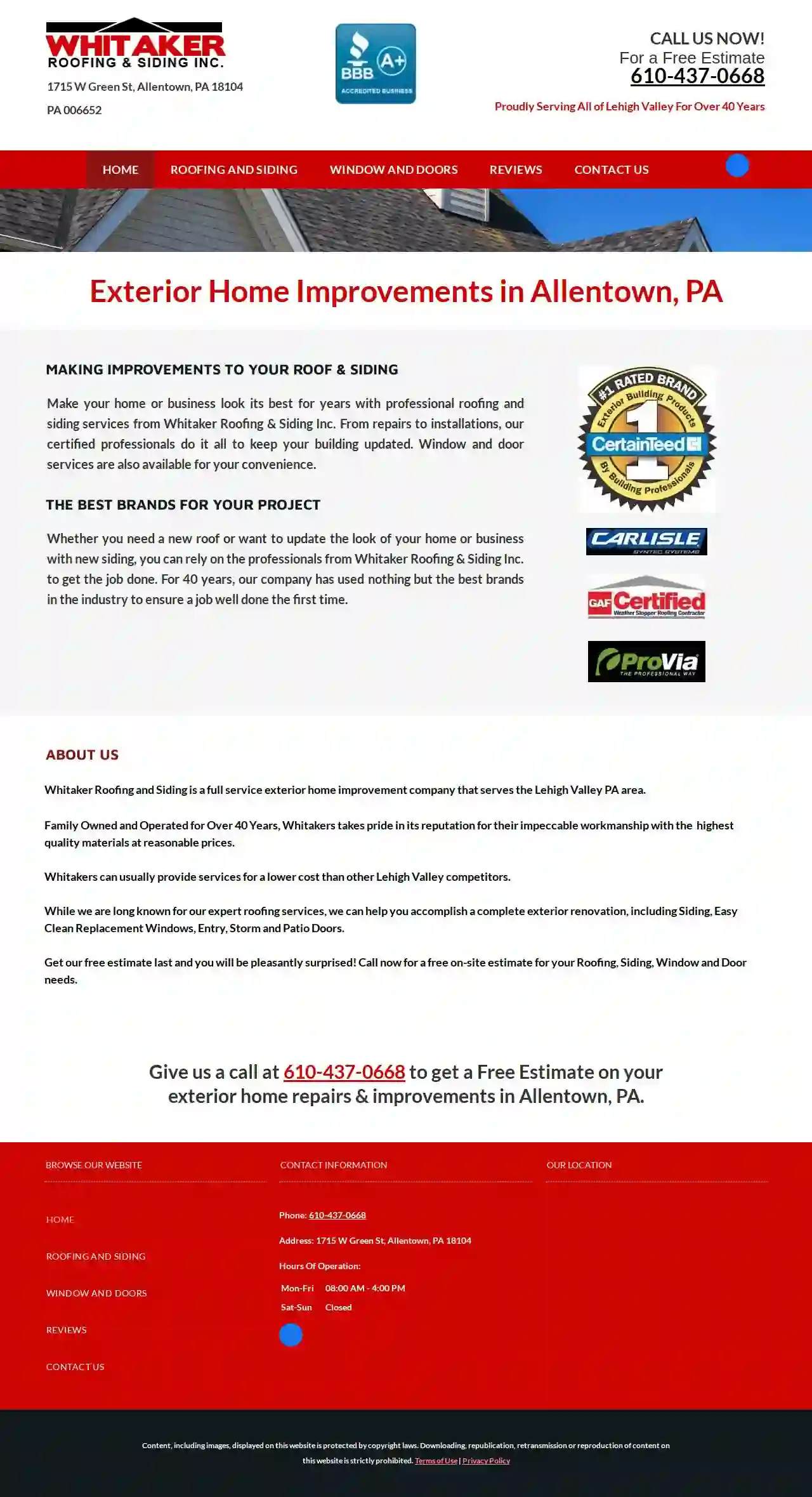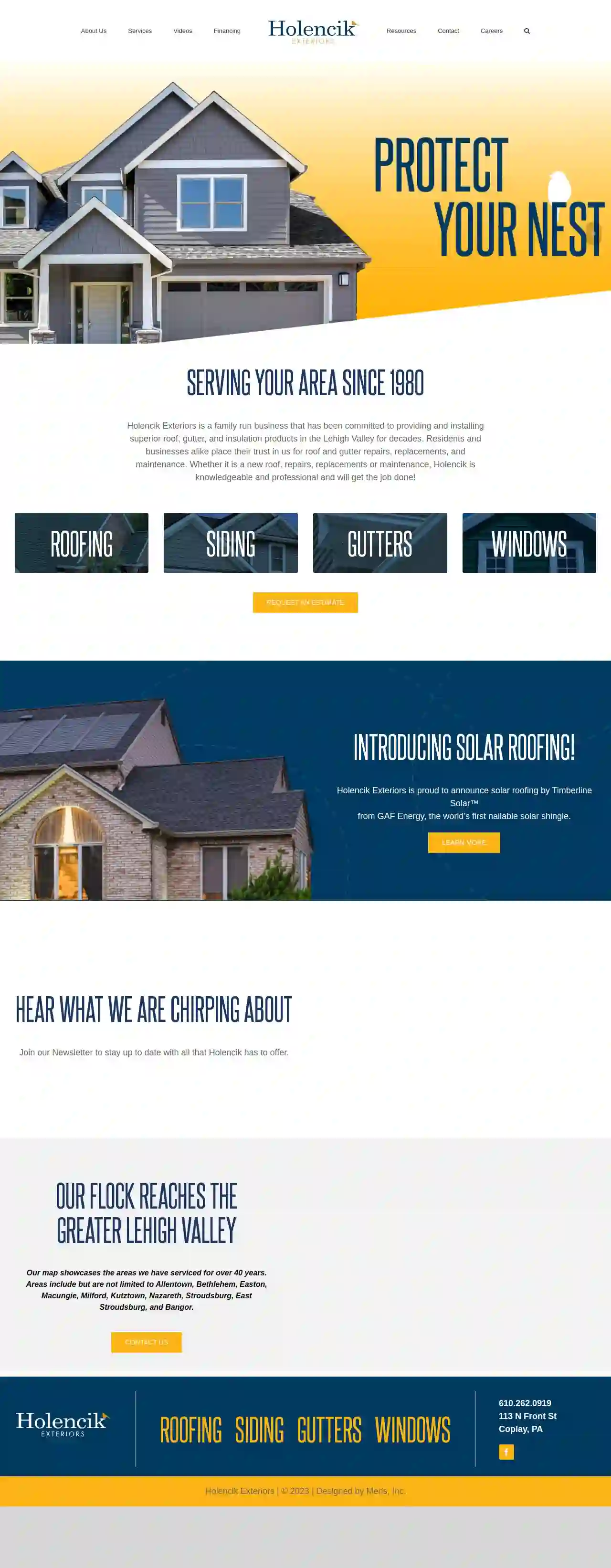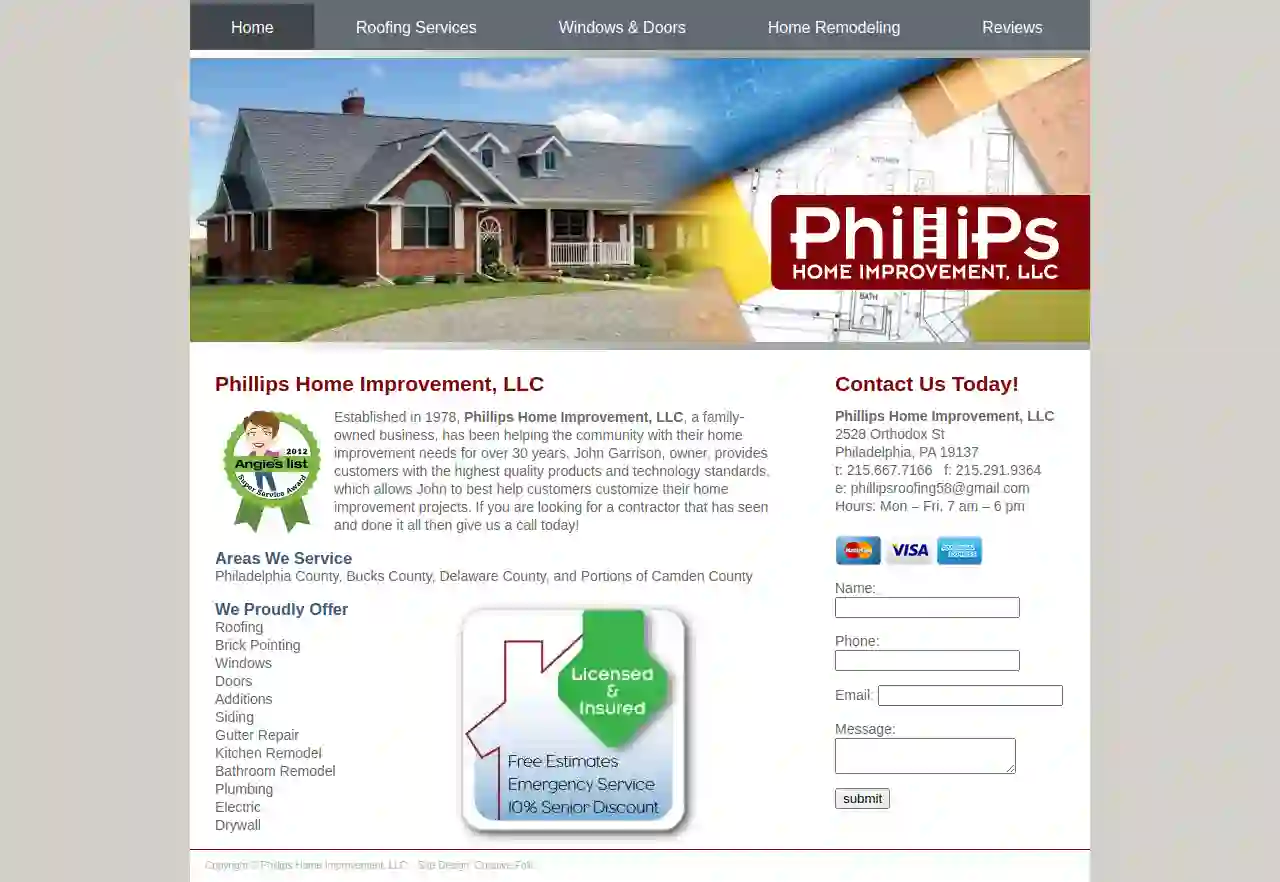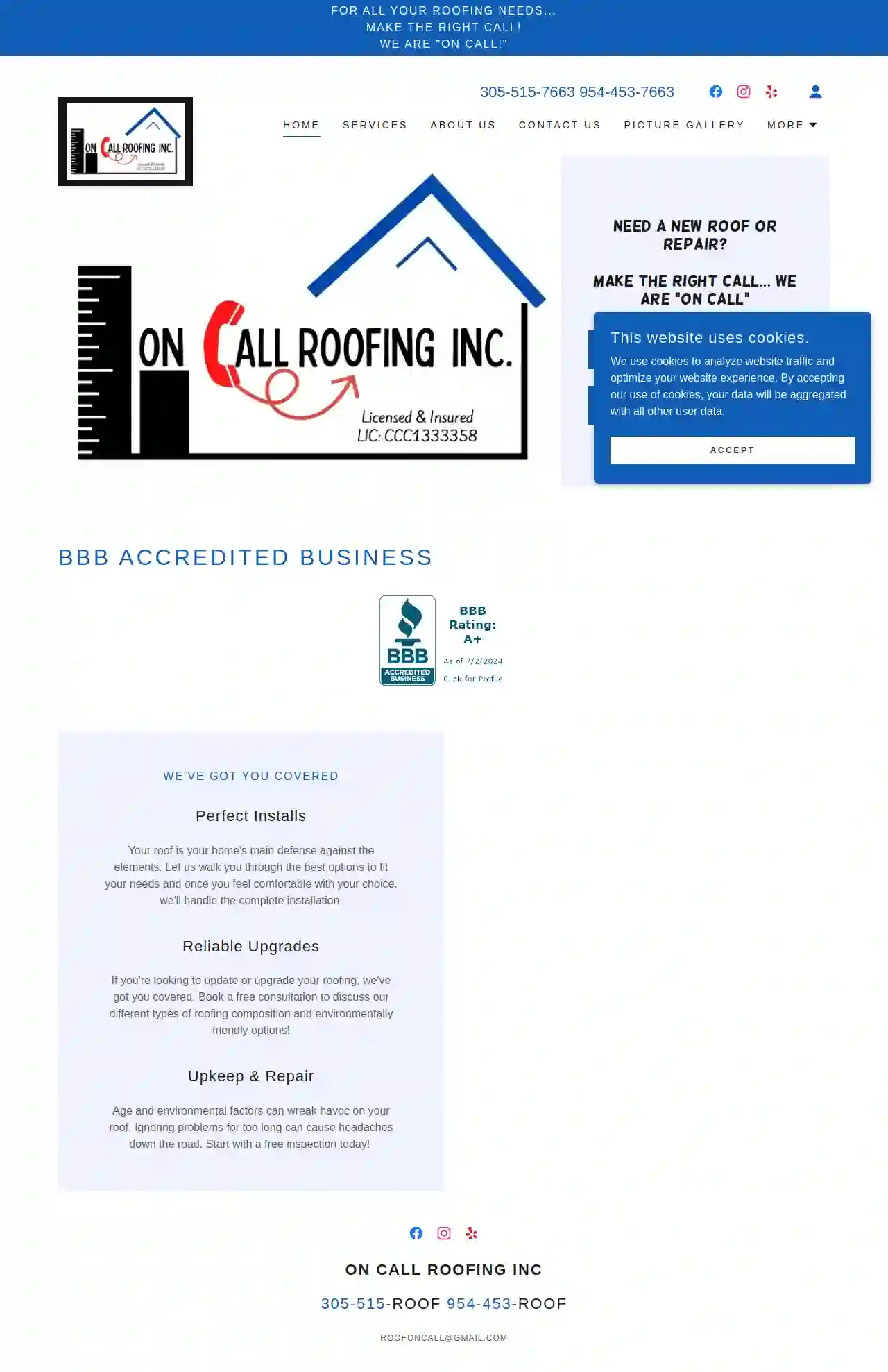Roofing Companies Weisenberg
Find Roofers in Weisenberg
Receive multiple Roofing Contractor quotes for your project today! Compare profiles, reviews, accreditations, portfolio, etc... and choose the best offer.

Whitaker Roofing & Siding Inc
424 reviews1715 W Green St, Allentown, 18104, USWhitaker Roofing & Siding Inc. is a family-owned and operated business serving the Lehigh Valley PA area for over 40 years. We specialize in exterior home improvements, including roofing, siding, windows, and doors. Our certified professionals provide high-quality workmanship using the best brands in the industry to ensure a job well done. We pride ourselves on our reputation for exceptional customer service and competitive pricing. Whether you need a new roof, siding updates, or window and door replacements, Whitaker Roofing & Siding Inc. is your trusted partner for all your exterior home improvement needs. Call us today for a free on-site estimate and experience the Whitaker difference!
- Services
- Why Us?
- Our Team
- Testimonials
- Gallery
Get Quote
Farrell’s Roofing
530 reviewsFive Greentree Centre, 525 Route 73 North, STE 104, Marlton, 08053, USFARRELL'S ROOFINGRoofing Experts You Can Trust. Serving Philadelphia, Bucks County. Montgomery County, & New Jersey. Call Now (215) 501-0276 Trusted In Philadelphia For Over 23 Years!Farrell’s Roofing is a family owned & operated roofing company serving the Philadelphia and surrounding areas since 1997. Our services include Roofing, Siding, Gutters, Shingles, Capping, Silver Coat & More! We are Licensed and Insured for residential and Commercial work. Quality Roofing Services. No matter what type of project you need completed, our team here at Farrell’s Roofing can handle it. From new roof installations on commercial buildings to roof repair on a leaky home roof, Farrell’s Roofing provides prompt, high-quality work on time and within budget. Along with our years of expertise, we offer a labor guarantee in addition to manufacturer warranties on our roofing materials. That way, you can rest easy knowing that your property’s roof is protected for years to come. Learn More Why Farrell’s Roofing? We don’t believe in the one-size-fits-all method. We provide our services based on our customer’s individual needs. Farrell’s Roofing Founder Ray Farrell put it this way, “We dedicate our personal attention to each job. We understand that each situation is unique, and we strive to create a flexible solution that caters to our customer’s needs and budget.” So When you’re looking for a roofing company that has your best interest at heart, you can find confidence in choosing Farrell’s Roofing of Philadelphia! Learn More Check out some our recent work.Here’s a preview of some of the work we did in 2020-2021. It’s all about quality.Our dedication to customer satisfaction has been the key to our longevity as a leading roofing contractor in Philadelphia. And we have an extensive list of satisfied customers to prove it. In fact, customer service and quality craftsmanship are the cornerstones of our business at Farrell’s Roofing.We have a dedicated, experienced team who are eager to answer all of your questions and address any of your concerns. Each of our team members have been in the roofing & construction industry for many years and carry extensive knowledge with even the most complicated of roof projects. We pride ourselves in being true roofing industry professionals.Farrell’s Roofing of Philadelphia is a "full service" roofing company, with hundreds of roofing and rain gutter installations across Philadelphia & the Tri State area. Our re-roof projects have covered everything from asphalt shingles, wood shakes, tile roofs, standing seam metal roofs, roof coatings and single-ply roof systems, to a variety of services from roof maintenance, roof repairs, solar installations and rain gutters. All of our clients are treated with the "personal touch" that Farrell's Roofing has become known for. No roofing project is too big or too small for us.
- Services
- Why Us?
- Gallery
Get Quote
Beacon Building Products
4.241 reviewsErie, USBeacon Roofing Supply is a leading employer, trusted supplier, and reputable partner in the communities they serve. With a massive network of 530+ locations in the U.S. & Canada, they provide a suite of digital resources like automated order workflows, live pricing, material ordering, and mobile delivery tracking. They are dedicated to the success of contractors, from the first quote to the final invoice.
- Services
- Why Us?
- Gallery
Get Quote
Last Stop Roofing & Home Repair, LLC
4.961 reviewsPhiladelphia, USWelcome to Last Stop Roofing & Home Repair LLC, your premier roofing company serving Philadelphia, Bucks County, Montgomery County, and Delaware County. We are dedicated to providing high-quality roofing services tailored to meet the diverse needs of our customers. We specialize in asphalt shingles roof installations. Whether you need a new roof for your home or business, our experienced team will ensure that your project is completed with precision and efficiency. We offer a wide range of asphalt shingles, allowing you to choose the style and color that best complements your property's aesthetic. As experts in row home roofing, we understand the unique challenges and requirements of these historical structures. Our skilled professionals take pride in preserving the architectural integrity of row homes while delivering reliable and durable roofing solutions. With our expertise, you can trust that your row home's roof will be in safe hands. Regular roof maintenance is crucial for prolonging the lifespan of your roof and preventing costly repairs. Our team is well-equipped to provide comprehensive roof maintenance services, including inspections, cleaning, and repairs. By identifying and addressing any issues early on, we help you avoid potential roof damage and extend the life of your investment. In addition to roofing services, we also offer vinyl siding installations to enhance the appearance and protection of your property. Our vinyl siding options are durable, low-maintenance, and available in various styles and colors to suit your preferences. With our expertise, you can transform the exterior of your home or business with a beautiful and long-lasting siding solution. To make your roofing project more affordable, we are proud to offer financing options through GreenSky Financing. Our flexible financing plans allow you to complete your roofing project without straining your budget. We understand that a new roof is a significant investment, and our financing options make it more accessible for our valued customers. No matter your roofing needs, Last Stop Roofing & Home Repair LLC is here to serve you. Contact us today to schedule a consultation and experience the exceptional service and expertise that sets us apart. Trust your roofing project to the professionals who understand the unique requirements of Philadelphia, Bucks County, Montgomery County, and Delaware County.
- Services
- Why Us?
- Our Team
- Testimonials
- Gallery
Get Quote
Holencik Exteriors
4.8488 reviews113 North Front Street, Coplay, 18037, USHolencik Exteriors is a family run business that has been committed to providing and installing superior roof, gutter, and insulation products in the Lehigh Valley for decades. Residents and businesses alike place their trust in us for roof and gutter repairs, replacements, and maintenance. Whether it is a new roof, repairs, replacements or maintenance, Holencik is knowledgeable and professional and will get the job done!
- Services
- Why Us?
- Gallery
Get Quote
Hollywood Roofing Experts
57 reviews6710 Greene St, Hollywood, 33024, USHollywood Roofing Experts is a reputable roofing company in Hollywood, Florida, offering a wide range of roofing services, including roof replacement, tile roof replacement, asphalt shingle roof replacement, metal roof replacement, roof repairs, and commercial roofing. Our team of experts has years of experience in the industry and is dedicated to providing top-notch services to our clients. We understand the importance of a sturdy roof and the impact it can have on a property's value and functionality. That's why we use only the highest-quality materials and employ the latest techniques to ensure that our clients receive the best possible results. Whether you're looking for a new roof or need repairs, we're here to help. Contact us today to schedule a consultation and learn more about our services.
- Services
- Why Us?
- Accreditations
- Our Team
- Testimonials
- Gallery
Get Quote
Roofing & construction LLC
59 reviewsYork, USRoofing & Construction NY is a full-service roofing and construction company serving the New York metropolitan area. We specialize in residential and commercial roofing, as well as a wide range of construction services. Our team of experienced professionals is dedicated to providing our clients with the highest quality workmanship and customer service. We are fully licensed and insured, and we stand behind our work with a 100% satisfaction guarantee. We offer a variety of roofing services, including: New roof installations Roof repairs Roof replacements Roof inspections Gutter cleaning and repair We also offer a variety of construction services, including: \n Siding Windows Doors Decks Fences Contact us today for a free estimate.
- Services
- Why Us?
- Gallery
Get Quote
Phillips Home Improvement & Roofing LLC
2.58 reviews2528 Orthodox St, Philadelphia, 19137, USEstablished in 1978, Phillips Home Improvement, LLC, a family-owned business, has been helping the community with their home improvement needs for over 30 years. John Garrison, owner, provides customers with the highest quality products and technology standards, which allows John to best help customers customize their home improvement projects. If you are looking for a contractor that has seen and done it all then give us a call today!
- Services
- Why Us?
- Our Team
- Testimonials
- Gallery
Get Quote
Uncle Al’s Roofing
517 reviewsPhiladelphia, USUncle Al's Roofing is a trusted professional roofing service serving Philadelphia, PA, NJ, DE & surrounding areas. For more than 10 years, we have helped countless home owners by repairing all roofing issues successfully. We offer premium quality roofing materials, a large selection of roofing options, and reliable service with 100% Guarantees on ALL services. Our team of experts is dedicated to providing fast, reliable, and dependable quality service to help you with all your roofing needs.
- Services
- Why Us?
- Testimonials
- Gallery
Get Quote
On Call Roofing Inc.
Erie, USFor all your roofing needs... Make the right call! We are "ON CALL"! 305-515-7663 954-453-7663. We've Got You Covered. Perfect Installs. Your roof is your home's main defense against the elements. Let us walk you through the best options to fit your needs and once you feel comfortable with your choice, we'll handle the complete installation. Reliable Upgrades. If you're looking to update or upgrade your roofing, we've got you covered. Book a free consultation to discuss our different types of roofing composition and environmentally friendly options! Upkeep & Repair. Age and environmental factors can wreak havoc on your roof. Ignoring problems for too long can cause headaches down the road. Start with a free inspection today!
- Services
- Why Us?
- Accreditations
- Our Team
- Gallery
Get Quote
Over 17,196+ Roofers in our network
Our roofing experts operate in Weisenberg and beyond!
Roofyng.com has curated and vetted Top Roofers near Weisenberg. Find a reliable pro today.
Frequently Asked Questions About Roofing Companies
- Roof size and complexity
- Roofing material chosen
- Local labor costs
- Accessibility of the roof
- Removal of existing roofing
- Additional features (skylights, chimneys, etc.)
- Hot Climates: Opt for light-colored or reflective roofing materials to reduce heat absorption. Consider tile roofs for their thermal mass and heat resistance.
- Cold Climates: Ensure your roof has adequate insulation and ventilation to prevent ice dams and moisture buildup. Metal roofs can shed snow effectively.
- High-Wind Areas: Choose roofing systems with high wind ratings and properly installed hurricane straps or clips to enhance wind resistance.
- Areas with Heavy Rainfall: Ensure your roof has proper drainage and a waterproof membrane to prevent leaks.
How much does a new roof cost in the USA?
What is the difference between a roof overlay and a roof tear-off?
Roof Overlay: Installing a new layer of roofing material over the existing roof. It's less expensive and faster, but not always ideal.
Roof Tear-Off: Completely removing the existing roofing before installing a new one. More labor-intensive but allows for inspection and repairs to the roof deck.
A tear-off is typically preferred, but a roofing contractor can advise on the best approach for your situation.
What should I do with my old roof after replacement?
How do I choose the right type of roof for my climate?
How much does a new roof cost in the USA?
- Roof size and complexity
- Roofing material chosen
- Local labor costs
- Accessibility of the roof
- Removal of existing roofing
- Additional features (skylights, chimneys, etc.)
What is the difference between a roof overlay and a roof tear-off?
Roof Overlay: Installing a new layer of roofing material over the existing roof. It's less expensive and faster, but not always ideal.
Roof Tear-Off: Completely removing the existing roofing before installing a new one. More labor-intensive but allows for inspection and repairs to the roof deck.
A tear-off is typically preferred, but a roofing contractor can advise on the best approach for your situation.
What should I do with my old roof after replacement?
How do I choose the right type of roof for my climate?
- Hot Climates: Opt for light-colored or reflective roofing materials to reduce heat absorption. Consider tile roofs for their thermal mass and heat resistance.
- Cold Climates: Ensure your roof has adequate insulation and ventilation to prevent ice dams and moisture buildup. Metal roofs can shed snow effectively.
- High-Wind Areas: Choose roofing systems with high wind ratings and properly installed hurricane straps or clips to enhance wind resistance.
- Areas with Heavy Rainfall: Ensure your roof has proper drainage and a waterproof membrane to prevent leaks.